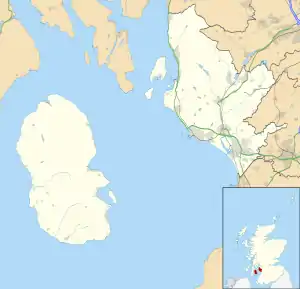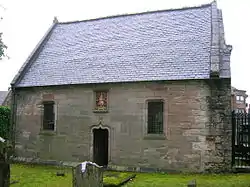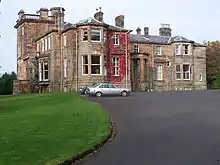Skelmorlie
Skelmorlie is a village in North Ayrshire, Scotland. Although it is the northernmost settlement in the council area of North Ayrshire it is contiguous with Wemyss Bay, which is in Inverclyde. The dividing line is the Kelly Burn, which flows into the Firth of Clyde just south of the Rothesay ferry terminal. Despite their proximity, the two villages have historically been divided, Skelmorlie in Ayrshire and Wemyss Bay in Renfrewshire.
| Skelmorlie | |
|---|---|
 Skelmorlie and Wemyss Bay Parish Church | |
 Skelmorlie Location within North Ayrshire | |
| OS grid reference | NS195688 |
| Council area | |
| Lieutenancy area | |
| Country | Scotland |
| Sovereign state | United Kingdom |
| Post town | SKELMORLIE |
| Postcode district | PA17 |
| Dialling code | 01475 |
| Police | Scotland |
| Fire | Scottish |
| Ambulance | Scottish |
| UK Parliament | |
| Scottish Parliament | |
Skelmorlie itself is divided into two sections, Lower and Upper Skelmorlie. There is one primary school in the village, with secondary age pupils going to Largs Academy in North Ayrshire. In common with this part of the Clyde foreshore the rich red sandstone is a prominent feature of the landscape and housing in Skelmorlie.
Early Skelmorlie
Nestled on a plateau and situated 30-60m above the sea-level. Overlooking the four-mile wide Firth of Clyde to the beginning of the Scottish Highlands. The outstanding panoramic view from the area stretches from Arran and the "sleeping warrior" in the south west to the mountains either side of Loch Long to the North.
It is known that "a significant population" lived around the area behind the present-day Manor Park Hotel in the 9th to 11th century and evidence supports the theory that an early Celtic church existed there before the arrival of the Cluniac Monks (who formed Paisley Abbey in 1163) and the foundation of the Roman Church.
The land on which the modern day village now stands was passed from King Malcolm III to the Cunninghames and subsequently acquired by Sir Alexander de Montgomerie of Ardrossan on 25 March 1453 when his sister Anne married Sir Robert Cunninghame of Kilmaurs.
The Montgomeries were Normans, descended from William the Conqueror's great grandmother. There were thirteen Montgomeries of Skelmorlie, the line was founded in 1461 by George Montgomerie, 2nd son of the first lord Montgomerie.
The earliest known record of a "building" in the village is a building in the shape of a simple Keep which was built around 1502 on the site of what is now Skelmorlie Castle. This Keep was in the corner of the castle nearest Stirrats Farm.
There were six baronets (a holder of a hereditary title awarded by the British Crown titled Sir but never entitled to sit in Lords) starting with Sir Robert Montgomerie in 1628 (knighted by James VI and who attended his own funeral and wept with the mourners in 1651) and ending with Sir Hugh Montgomerie who was very active in the political affairs of Glasgow being both Provost and MP for Glasgow, he was also a commissioner of the Treaty of the Union.
Sir Hugh's nephew Robert had an elder daughter called Lilias whose marriage united the estate to the senior branch of the Family of Eglinton. The Cunninghames held the northern part of Skelmorlie for a while before passing it to the Montgomeries, the split was the burn at the Meigle. The Southern half was further split into two - nearest the south was Blackhouse (on or near to the site of the Manor Park Hotel) and nearest the north was Thirdpart, Barr, Moat and Auchengarth.
The area of Knock entered into the possession of John, 1st Montgomerie of Blackhouse when his son Patrick married a Frazer of Knock. A feu charter in favour of "Patrick Montgomerie of Blackhous" can still be seen in the Manor Park Hotel.
Patrick was succeeded by Hugh Montgomerie and then by John Montgomerie. John was a lieutenant Colonel in the Covenanters who was killed fighting Cromwell at Dunbar, his heir, also Patrick sold the estate to the Bannatynes of Kelly in 1633 and was the last of the Montgomeries of Blackhouse. The estate stayed part of the Kelly estate until the 1800s
When Kelly Castle was burnt in 1740 the Bannatynes moved into Blackhouse which they had owned for a century. They sold it in 1780 and bought it back in 1795 after Kelly was sold.
The 18th Century saw the end of feudal society (where peasants worked the land and contributed work to their land'lords') and the growth of industry. Communities were beginning to form at Finnock (Inverkip), Kellybridge and Skelmorlie (Meigle, North Ayrshire|Meigle). Simultaneously, some of this population was moving and accumulating in Largs.
Most significantly, the 18th century saw the rise in the importance of the River Clyde and the increase in trade that it brought.
The original road from Greenock went up Station Hill, up Skelmorlie Castle Road, down past the Castle, veered left (never reaching where the main road is now) then back up through Meigle to Largs. It was close to this road on the high ground that all the habitation existed.
The area between the Kelly Burn and the track from Innes Park Road to Skelmorlie Community Centre was renamed Oakfield. That's the extremely short version. The highlights of the rest can be seen in the Chronology of local events.
History

Skelmorlie's history is recorded as far back as the fifteenth century. Skelmorlie Castle, south of the village, is a tower house built on the site of an older structure in 1502. Much altered and added to since, it is an ancient seat of the Clan Montgomery (a notable burial tomb of the family can be seen at Skelmorlie Aisle in Largs). During the nineteenth century the village was once home to many Glasgow tea barons. On the cliff above the shore a large hydropathic institution[1][2] once stood, with access from the main road via a lift whose shaft was hewn out of the rock face. The building later operated as a hotel, but was demolished in the 1990s.
To the south of Skelmorlie is the serpent mound, a prehistoric, perhaps druidic, site apparently carved either deliberately for religious uses or by nature then reused due to its natural shape.
On Saturday 18 April 1925, an embankment on the reservoir which belonged to the Eglinton Estate and provided the main water supply for the whole village gave way, releasing millions of gallons of water down through the village. After 10 minutes many homes, streets and gardens were shattered and five people, four of them children, lay dead.[3]
The composer and arranger Brian Fahey and his wife Audrey lived in Skelmorlie from 1972 until her death in 2006.[4] Nowadays Skelmorlie has a population of 1880 residents.
In the early part of the 20th century the Royal Navy used a measured nautical mile in the Firth of Clyde off Skelmorlie, known as the 'Skelmorlie Mile' as the range for speed trials of new warships.
Further reading

- Skelmorlie by Walter Smart, published locally in 1969. Now out of print but a useful source of local history. Available on-line at Scribd
References
- Bradley, James; Dupree, Mageurite; Durie, Alastair (1997). "Taking the Water Cure: The Hydropathic Movement in Scotland, 1840-1940" (PDF). Business and Economic History. 26 (2): 429. Retrieved 17 November 2009.
- Shifrin, Malcolm (3 October 2008). "Victorian Turkish Baths Directory". Victorian Turkish Baths: Their origin, development, and gradual decline. Retrieved 12 December 2009.
- "The Skelmorlie reservoir disaster of 1925".
- Black, Jim (2 August 2007). "Obituary: Brian Fahey". The Guardian.
![]() Media related to Skelmorlie at Wikimedia Commons
Media related to Skelmorlie at Wikimedia Commons